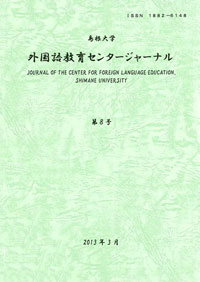島根大学外国語教育センター
ISSN:1882-6148

ダウンロード数 : ? 件
この文献の参照には次のURLをご利用ください : https://ir.lib.shimane-u.ac.jp/6482
島根大学外国語教育センタージャーナル 2
2007-03 発行
Teaching Effective Second Language Listening
Lieske Carmella
ファイル
内容記述(抄録等)
In Japan, listening is given focused attention in the second language (L2) classroom.
This paper begins by reviewing the nature of listening as well as the processing
involved when listening. Content validity, purposefulness and transferability,
listening or memory considerations, a teaching or testing orientation, and authentic
listening are discussed. By examining these five elements of effective listening
materials and also factors that affect comprehension, instructors can evaluate
textbooks and create materials that best meet the needs of their learners. This paper
explores the need to supplement textbooks with listening strategy instruction that
integrates micro-skill training with a variety of listening purposes and all of the
aspects of the nature of listening. The article concludes with a practical example of
how theory was successfully applied in the development of L2 materials for a
Japanese junior college class.
This paper begins by reviewing the nature of listening as well as the processing
involved when listening. Content validity, purposefulness and transferability,
listening or memory considerations, a teaching or testing orientation, and authentic
listening are discussed. By examining these five elements of effective listening
materials and also factors that affect comprehension, instructors can evaluate
textbooks and create materials that best meet the needs of their learners. This paper
explores the need to supplement textbooks with listening strategy instruction that
integrates micro-skill training with a variety of listening purposes and all of the
aspects of the nature of listening. The article concludes with a practical example of
how theory was successfully applied in the development of L2 materials for a
Japanese junior college class.
About This Article
Other Article
